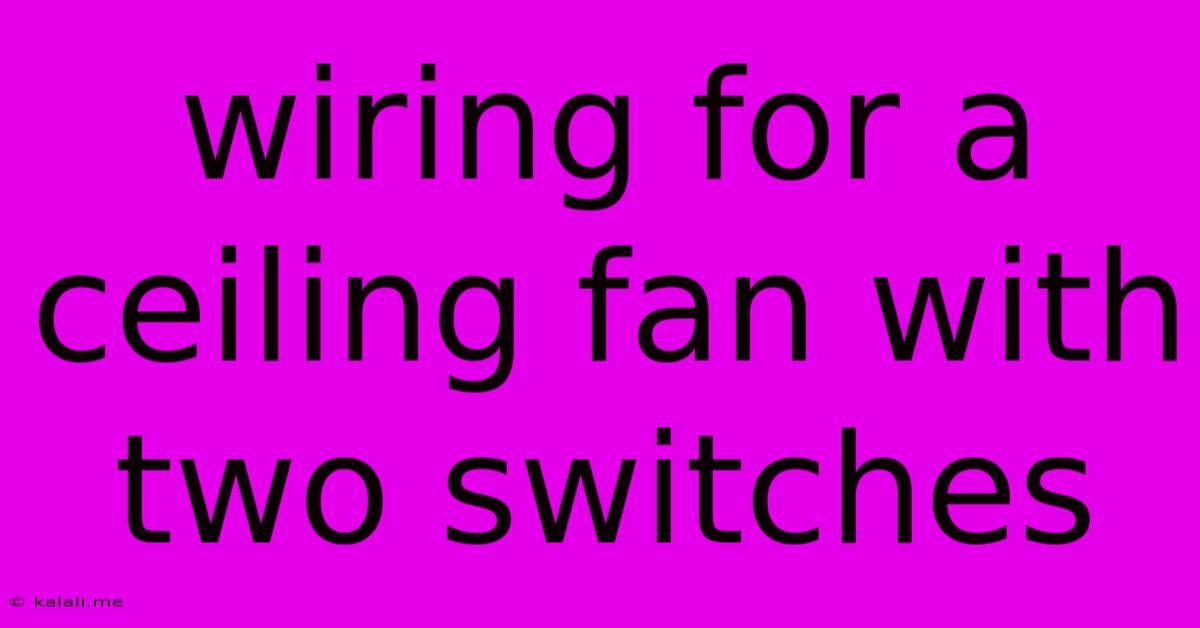Wiring For A Ceiling Fan With Two Switches
Kalali
May 24, 2025 · 4 min read

Table of Contents
Wiring a Ceiling Fan with Two Switches: A Comprehensive Guide
Meta Description: Learn how to wire a ceiling fan with two switches for convenient control from two different locations in your home. This comprehensive guide provides step-by-step instructions and safety tips.
Installing a ceiling fan controlled by two switches offers unparalleled convenience, allowing you to operate the fan from different points in a room – say, by the door and near the bed. This guide will walk you through the entire process, ensuring a safe and successful installation. We'll cover everything from gathering the necessary tools and materials to troubleshooting potential issues. Remember to always prioritize safety and consult a qualified electrician if you're unsure about any step.
Understanding the Setup
Before diving into the wiring, let's understand the functionality. A ceiling fan with two switches utilizes a three-way switch configuration. This means you'll have one switch at each location, and each switch influences the state (on, off, or speed) of the fan. The key components are:
- Ceiling Fan: Your chosen ceiling fan, complete with its wiring harness. Note the wiring colors; they might vary slightly depending on the brand and model.
- Three-Way Switches: Two three-way switches are crucial for independent control. They're distinguishable from single-pole switches by having three terminals instead of two.
- Electrical Box: Ensure the existing electrical boxes at both switch locations are securely mounted and capable of handling the additional wiring.
- Wiring: Sufficient 14/2 gauge or 12/2 gauge wiring (depending on the fan's amperage) to connect the fan and switches. The gauge refers to the thickness of the wire and is crucial for carrying the required current. Thicker wire (12 gauge) is used for higher amperage fans.
- Wire Connectors: Wire nuts are used to securely connect the wires together. Choose the appropriate size based on the number of wires being joined.
Step-by-Step Wiring Instructions
Safety First: Always turn off the power at the breaker box before starting any electrical work. Double-check the power is off using a non-contact voltage tester to prevent electrical shock.
-
Prepare the Wiring: Run the wiring from the ceiling fan electrical box to both switch locations. You'll need to feed the wires through the walls and ceilings; if you need to fish wires through existing walls, consider using a fish tape to make the task easier. Secure the wires within the walls and ceilings using appropriate fasteners and methods to prevent damage or future movement of the wiring.
-
Connect the Fan Wiring: This step depends on your specific fan model, but generally involves connecting the following wires:
- Black (Hot): Connects to the black wire from the switch.
- White (Neutral): Connects to the white neutral wire from the switch.
- Green/Bare Copper (Ground): Connects to the green or bare copper ground wire from the switch and the electrical box.
- Blue/Other Colored Wires (Fan Speed Control): These are used to control the speed settings of the ceiling fan and connect accordingly to the switch box. The exact wiring may vary depending on the fan's specific model and features.
-
Connect the Three-Way Switches: Each switch box will have black, red, and white wires (neutral wire). These need to be connected correctly to the three-way switches using wire connectors.
- Black wire from the ceiling fan: Connects to the common terminal of one of the switches.
- Traveler wires (black and red): Connect to the traveler terminals on both switches (ensure black connects to black and red connects to red on each switch).
- Neutral wires (white): Connect all the white wires together using a wire nut.
- Ground wires (green/bare copper): Connect all the ground wires together using a wire nut and ensure it's connected to the switch box ground.
-
Mount the Switches and Fan: Securely mount both three-way switches in their boxes and the ceiling fan to its electrical box.
-
Restore Power and Test: Turn the power back on at the breaker box. Test both switches to ensure they control the fan correctly. If the fan doesn’t work, carefully double-check all connections.
Troubleshooting
If your fan doesn't work after installation, here are some common troubleshooting steps:
- Check the Power: Verify the power is on at the breaker box.
- Check the Wiring: Meticulously inspect all wire connections to ensure they are secure and correctly connected. Look for loose wires or poor wire nut connections.
- Test the Switches: Try replacing one or both switches if you suspect a malfunction.
- Check the Fan Motor: If the fan still doesn't work, there may be a problem with the fan motor itself.
Remember, working with electricity can be dangerous. If you are not comfortable with these steps, it's always best to hire a licensed electrician. This guide is for informational purposes only and does not constitute professional electrical advice.
Latest Posts
Latest Posts
-
Simple Deform Bends On Z But Not Y
May 24, 2025
-
Freezer Not Freezing But Fridge Is Cold
May 24, 2025
-
When To Remove Dead Kitten From Mother
May 24, 2025
-
Linux How To Show Event Of Dev Input Event
May 24, 2025
-
Running A Fan On Only 2 Wires
May 24, 2025
Related Post
Thank you for visiting our website which covers about Wiring For A Ceiling Fan With Two Switches . We hope the information provided has been useful to you. Feel free to contact us if you have any questions or need further assistance. See you next time and don't miss to bookmark.